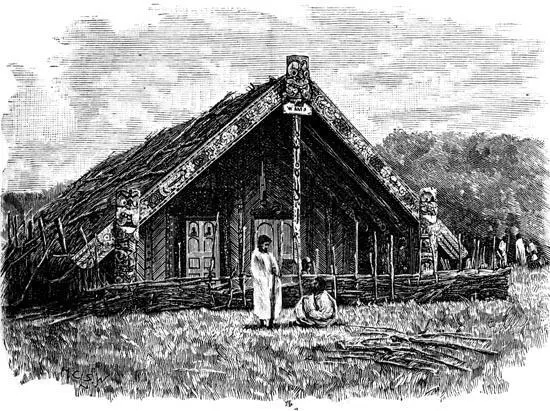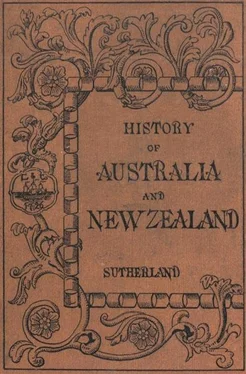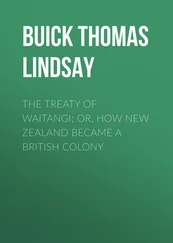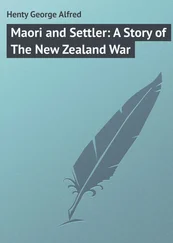CHAPTER XXIII.
THE TIMES OF THE MAORIS.
1. The Maoris.—So far as we know, the original inhabitants of New Zealand were a dark-skinned race called Maoris, a people lithe and handsome of body, though generally plain of features: open, frank and happy in youth, grave and often melancholy in their older years.
They numbered forty thousand in the North Island, where the warmth of the climate suited them, but in the South Island there were only two thousand. They were divided into tribes, who fought fiercely with one another; cooked and ate the bodies of the slain, and carried off the vanquished to be slaves. They dwelt in houses sometimes neatly built of wooden slabs, more often of upright poles with broad grass leaves woven between them. The roofs were of grass, plaited and thatched.
To these abodes the entrances were only some two or three feet high, and after crawling through, the visitor who entered at night would see the master of the house, his wives, his children, his slaves, indeed all his household, to the number of twenty or thirty, lying on mats in rows down either side, with their heads to the walls and their feet to the centre, leaving a path down the middle. In these rooms they slept, with a fire burning all night, till, what with the smoke and the breaths of so many people, the place was stifling. The roofs were only four feet higher than the ground outside, but, then, inside, the earth was hollowed a foot or two to make the floor so that a man could just stand upright.
These houses were gathered in little villages, often pleasantly situated beside a stream, or on the sea-shore; but sometimes for defence they were placed on a hill and surrounded by high fences with ditches and earthen walls so as to make a great stronghold of the kind they called a “pah”. The trenches were sometimes twenty or thirty feet deep; but generally the pah was built so that a rapid river or high precipices would defend two or three sides of it, while only the sides not so guarded by nature were secured by ditches and a double row of palisades. Within these enclosures stages were erected behind the palisades so that the fighting men could hurl stones and spears and defy an attacking party.

A Maori Dwelling.
2. Maori Customs.—Round their villages and pahs they dug up the soil and planted the sweet potato, and the taro, which is the root of a kind of arum lily; they also grew the gourd called calabash, from whose hard rind they made pots and bowls and dishes. When the crops of sweet potato and taro were over they went out into the forest and gathered the roots of certain sorts of ferns, which they dried and kept for their winter food. They netted fish and eels; they caught sharks with hook and line and dried their flesh in the sun. To enjoy these meals in comfort they had a broad verandah round their houses which formed an open and generally pleasant dining-room, where they gathered in family circles bound by much affection for one another. The girls especially were sweet and pretty; their mild manners, their soft and musical voices, the long lashes of their drooping eyes, with the gloss of their olive-tinted skins made them perfect types of dusky beauty. Grown a little older they were by no means so attractive, and then when married they deeply scored their faces by the process of tattooing.
The men had their faces, hips, and thighs tattooed, that is, all carved in wavy lines which were arranged in intricate patterns. The women tattooed only their lips, chins, and eyelids, but often smeared their faces with red ochre, and soaked their hair with oil. Men and women wore round the waist a kilt of beautifully woven flax, and over the shoulders a mat of the same material. They were expert sailors, and built themselves large canoes which thirty or forty men would drive forward, keeping time with their paddles. Their large war canoes were sixty and seventy feet long, and would carry 100 men.
Thus they were by no means uncivilised, but their condition was in some respects most barbarous. In person they were dirty, and in manners proud and arrogant. They were easily offended, and never forgave what they considered as an injury or insult. This readiness to take offence and to avenge themselves caused the neighbouring tribes to be for ever at war. They fought with great bravery, slaughtered each other fiercely, and ate the bodies. Sometimes they killed their captives or slaves in order to hold a cannibal feast.
According to their own traditions they had not been always in these islands. Their ancestors came from afar, and each tribe had its own legendary account. But they all agreed that they came from an island away to the north in the Pacific, which they called Hawaiki, and there is little doubt but that some hundreds of years ago their forefathers must in truth have emigrated from some of the South Sea Islands. Whether they found natives on the islands and killed them all, we cannot now discover. There are no traces of any earlier people, but the Maoris in their traditions say that people were found on the islands and slain and eaten by the invaders.
One tribe declared that long ago in far-off Hawaiki a chief hated another, but was too weak to do him harm. He fitted out a canoe for a long voyage, and suddenly murdered the son of his enemy. He then escaped on board the canoe with his followers and sailed away for ever from his home. This legend declared how after many adventures he at length reached New Zealand. Another legend relates that in Hawaiki the people were fighting, and a tribe being beaten was forced to leave the island. Sorrowfully it embarked in two canoes and sailed away out upon the tossing ocean, till, directed by the voice of their god sounding from the depths below them, they landed on the shores of New Zealand.
How many centuries they lived and multiplied there it is impossible to say, as they had no means of writing and recording their history.
3. Tasman.—The earliest we know of them for certain is in the journal of Tasman, who writes under the date of 13th December, 1642, that he had that day seen shores never before beheld by white men. He was then holding eastward after his visit to Tasmania, and the shore he saw was the mountainous land in the North Island. He rounded what we now call Cape Farewell, and anchored in a fine bay, whose green and pleasant shores were backed by high snow-capped mountains. Several canoes came off from the beach filled by Maoris, who lay about a stone’s throw distant and sounded their war trumpets. The Dutch replied by a flourish of their horns. For several days the Maoris would come no nearer, but on the sixth they paddled out with seven canoes and surrounded both vessels. Tasman noticed that they were crowding in a somewhat threatening manner round one of his ships, the Heemskirk , and he sent a small boat with seven men to warn the captain to be on his guard. When the Maoris saw these seven men without weapons sailing past their canoes they fell on them, instantly killed three and began to drag away their bodies; no doubt to be eaten. The other four Dutchmen, by diving and swimming, escaped and reached the ship half dead with fright. Then with shouts the whole line of Maori canoes advanced to attack the ships; but a broadside startled them. They were stupefied for a moment at the flash and roar of the cannon and the crash of the wood-work of their canoes; then they turned and fled, carrying with them, however, one of the bodies. Tasman sailed down into Cook Strait, which he very naturally took to be a bay, the weather being too thick for him to see the passage to the south-east. He then returned and coasted northwards to the extreme point of New Zealand, which he called Cape Maria Van Diemen, probably after the wife of that Governor of Batavia who had sent out the expedition. Tasman called the lands he had thus discovered “New Zealand,” after that province of Holland which is called Zealand, or the Sea-land. The bay in which he had anchored was called Murderers’ or Massacre Bay.
Читать дальше













